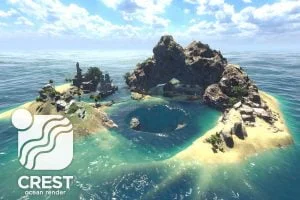Crest Ocean System URP
Description
There are no plans to support Unity 2023 or later at this stage. A new asset is being developed instead.
Features
All proceeds are invested back into new features to add to our growing list:
- Simulated light transport including reflection, refraction, scattering, caustics approximation, shadowing
- Wavey water with innovative ‘equalizer’ style wave authoring. Both FFT and Gerstner approaches supported
- Query water displacement using GPU or CPU
- Dynamic wave simulation (‘ripple sim’) for dynamic object-water interaction including boat wakes
- Innovative ‘wave spline’ tech to give detailed control over water simulation including rivers, lakes and shorelines
- Shallow water – light scattering and wave attenuation
- Apply colour onto ocean surface similar to decals
- Foam simulated from waves and shorelines
- Manipulate ocean data (like foam) using mesh, trail, line and particle renderers.
- Underwater effect with partial submersion and meniscus
- Water volumes which can restrict rendering of both surface and underwater to a given geometry (eg sphere of water)
- Shader Graph nodes for applying underwater to transparent objects
- Flow to enable horizontal motion of water volume
- Physics interface with simplistic buoyancy implementations and support for
Technical details
Crest primarily focuses on PC and console platforms, while also offering potential functionality on mobile devices. Its design emphasizes robustness, adaptability, and scalability, rather than a minimalistic or specialized approach solely aimed at maximizing performance.
Crest does not support OpenGL or WebGL. Quest 2 requires Vulkan.
Crest is targeted towards projects that require an advanced water simulation. This may not be the most suitable product for mobile games or for developers that need a very simple drop-in solution which does not require configuration.
Crest’s support for rendering multiple cameras simultaneously is limited. This limitation becomes apparent in scenarios like split-screen multiplayer, where the LOD detail centers around a single position, usually the main camera.
The Crest code contains MIT-licensed code. The copyright notices are specified in the included file ThirdPartyNotices.md.
Note! You have to pay for this item, but you can get it for free now. Remember, this is only for learning or trying out the product before you buy it, not for use in your business.


Post a Comment